Effect of Steel Fiber Content on the Electrical, Electrothermal, and Thermal Conductivity Properties of Iron Tailings-Based UHPC
Abstract
1. Introduction
2. Experiments and Testing
2.1. Experimental Materials
2.2. Testing Instruments
2.3. Sample Preparation
2.4. Testing Methods
3. Experimental Results and Analysis
3.1. Electrical Performance Analysis
3.2. Electrothermal Performance Analysis
3.3. Thermophysical Performance Analysis
3.4. Steel Fiber Distribution and Mechanism Analysis
4. Conclusions and Prospects
4.1. Conclusions
4.2. Limitations and Future Work
Author Contributions
Funding
Data Availability Statement
Conflicts of Interest
References
- Sun, L.; Liu, Y.; Han, Q.; Wang, L. Conceptual Design of Lightweight Assembled Double-Skinned UHPC Composite Pylons for Large-Span Suspension Bridges. Structures 2024, 70, 107725. [Google Scholar] [CrossRef]
- Abokifa, M.; Moustafa, M.A. Mechanical Characterization and Material Variability Effects of Emerging Non-Proprietary UHPC Mixes for Accelerated Bridge Construction Field Joints. Constr. Build. Mater. 2021, 308, 125064. [Google Scholar] [CrossRef]
- He, Q.-F.; Zou, J.-M.; Zhang, C.-F.; Zhong, Y.; Li, J.-S.; Yi, W.-J. Experimental Study on the Seismic Performance of Two-Storey UHPC Modular Building Structure. J. Build. Eng. 2024, 97, 110966. [Google Scholar] [CrossRef]
- Li, Y.; Zhao, C.; Li, H.; Liu, W. Study on the Toughness and Microstructure of UHPC with a High Steel Fiber Content. Constr. Build. Mater. 2025, 460, 139810. [Google Scholar] [CrossRef]
- Qin, H.; Ding, S.; Ashour, A.; Zheng, Q.; Han, B. Revolutionizing Infrastructure: The Evolving Landscape of Electricity-Based Multifunctional Concrete from Concept to Practice. Prog. Mater. Sci. 2024, 145, 101310. [Google Scholar] [CrossRef]
- Ding, S.; Dong, S.; Wang, X.; Ding, S.; Han, B.; Ou, J. Self-Heating Ultra-High Performance Concrete with Stainless Steel Wires for Active Deicing and Snow-Melting of Transportation Infrastructures. Cem. Concr. Compos. 2023, 138, 105005. [Google Scholar] [CrossRef]
- Bolina, F.L.; Lago, B.D.; Rodríguez, E.D. Effects of Thermal Properties on Temperature Field of UHPC Structures under Fire Conditions. Constr. Build. Mater. 2024, 411, 134254. [Google Scholar] [CrossRef]
- Sun, Z.; Li, Y.; Su, L.; Niu, D.; Luo, D.; He, W.; Xie, S. Investigation of Electrical Resistivity for Fiber-Reinforced Coral Aggregate Concrete. Constr. Build. Mater. 2024, 414, 135011. [Google Scholar] [CrossRef]
- Katlav, M.; Donmez, I.; Turk, K. Electrical Resistivity of Eco-Friendly Hybrid Fiber-Reinforced SCC: Effect of Ground Granulated Blast Furnace Slag and Copper Slag Content as Well as Hooked-End Fiber Length. Constr. Build. Mater. 2024, 438, 137235. [Google Scholar] [CrossRef]
- Quan, X.; Wang, S.; Liu, K.; Xu, J.; Zhang, K.; Zhao, N.; Li, B. Influence of Iron Ore Tailings By-Product on the Mechanical and Electrical Properties of Carbon Fiber Reinforced Cement-Based Composites. J. Build. Eng. 2022, 45, 103567. [Google Scholar] [CrossRef]
- AL-Saleem, N.K.; Ghrib, T.; AL-Naghmaish, A.; Elshekhipy, A.A.; Almalki, N.; Gmati, N.; Turki, N.K. Effect of Porosity on Structural, Optical, Thermal, and Electrical Properties of Nickel-Foam Coated Graphene Sheets. J. Mater. Res. Technol. 2022, 19, 300–313. [Google Scholar] [CrossRef]
- Rahman, M.L.; Malakooti, A.; Ceylan, H.; Kim, S.; Taylor, P.C. A Review of Electrically Conductive Concrete Heated Pavement System Technology: From the Laboratory to the Full-Scale Implementation. Constr. Build. Mater. 2022, 329, 127139. [Google Scholar] [CrossRef]
- Wang, X.; Liu, X.; Wu, Y.; Zhu, P.; Liu, H.; Chen, C.; Wang, F. Road Use and Electrothermal Performance of Graphene-Conductive Asphalt-Recycled Pervious Concrete under Severe Cold Environment. Constr. Build. Mater. 2023, 400, 132829. [Google Scholar] [CrossRef]
- Maglogianni, M.E.; Danoglidis, P.A.; Konsta-Gdoutos, M.S. Electrical-to-Thermal Energy Conversion Efficiency of Conductive Concrete. Cem. Concr. Compos. 2023, 139, 104992. [Google Scholar] [CrossRef]
- Yang, L.; Liu, Y.; Chen, Z.; Yang, Z.; Pei, Y.; Mao, H. Discrete Element Analysis of Heat Transfer Characteristics of Concrete Pavement under Electrical Heating for Snow Melting and Deicing. Constr. Build. Mater. 2024, 432, 136486. [Google Scholar] [CrossRef]
- Ding, S.; Wang, X.; Ashour, A.; Wang, D.; Sun, T.; Han, B. Developing Electrothermal Energy Storage System for Building Heating by Using Stainless Steel Wires Reinforced Ultra-High Performance Concrete. Compos. Part Appl. Sci. Manuf. 2025, 193, 108832. [Google Scholar] [CrossRef]
- Li, Y.; Hu, B.; Gao, Y.; Feng, J.; Kot, P. Electrical Characteristics and Conductivity Mechanism of Self-Sensing Asphalt Concrete. Constr. Build. Mater. 2024, 416, 135236. [Google Scholar] [CrossRef]
- Lu, D.; Jiang, X.; Leng, Z.; Huo, Y.; Wang, D.; Zhong, J. Electrically Conductive Asphalt Concrete for Smart and Sustainable Pavement Construction: A Review. Constr. Build. Mater. 2023, 406, 133433. [Google Scholar] [CrossRef]
- Bahmani, H.; Mostofinejad, D.; Eftekhar, M.R. A Novel Eco-Friendly Thermal-Insulating High-Performance Geopolymer Concrete Containing Calcium Oxide-Activated Materials with Waste Tire and Waste Polyethylene Terephthalate. Dev. Built Environ. 2024, 18, 100473. [Google Scholar] [CrossRef]
- Chen, G. Research progress on improving the thermal conductivity of phase change materials. New Chem. Mater. 2024, 52, 11–15. [Google Scholar] [CrossRef]
- Gencel, O.; Oguz, M.; Gholampour, A.; Ozbakkaloglu, T. Recycling Waste Concretes as Fine Aggregate and Fly Ash as Binder in Production of Thermal Insulating Foam Concretes. J. Build. Eng. 2021, 38, 102232. [Google Scholar] [CrossRef]
- Zhang, H. Study on Thermal and Energy Saving Performance of Aerogel Foamed Concrete Insulation Wall. Doctor’s Thesis, Guangzhou University, Guangzhou, China, 2024. [Google Scholar] [CrossRef]
- Zhu, L.; Lei, S.; Li, T. Investigation on Thermal Performance of Recycled Brick Aggregate Concrete Structural Walls. Constr. Build. Mater. 2024, 425, 136083. [Google Scholar] [CrossRef]
- Wang, Y. Experiments and Mesoscopic Numerical Analysis on Thermal Performance of Full Recycled Coarse Aggregate Concrete. Master’s Thesis, Henan University of Technology, Zhengzhou, China, 2024. [Google Scholar] [CrossRef]
- Charai, M.; Mezrhab, A.; Moga, L.; Karkri, M. Hygrothermal, Mechanical and Durability Assessment of Vegetable Concrete Mixes Made with Alfa Fibers for Structural and Thermal Insulating Applications. Constr. Build. Mater. 2022, 335, 127518. [Google Scholar] [CrossRef]
- Lyu, S.; Xiao, J.; Wang, B.; Lu, Y.; Sun, X. Influence of Sisal Fibers on Mechanical Properties and Thermal Conductivity of Fully Recycled Aggregate Concrete. Constr. Build. Mater. 2025, 470, 140478. [Google Scholar] [CrossRef]
- Hua, K. Research on the Thermal Conductivity of Concrete. J. Highw. Transp. Res. Dev. 2019, 15, 58–60. [Google Scholar]
- Zhang, H. Study of Graphite and Copper Slag Concrete Properties and Simulation of Thermal Conductivity of Energy Piles. Master’s Thesis, Hunan University, Changsha, China, 2023. [Google Scholar] [CrossRef]
- Shen, L.; Yao, X.; Zhu, D.; Alkayem, N.F.; Cao, M.; Ren, Q. A Thermal Cracking Pattern-Based Multiscale Homogenization Method for Effective Thermal Conductivity of Steel Fiber Reinforced Concrete after High Temperature. Int. J. Heat Mass Transf. 2021, 180, 121732. [Google Scholar] [CrossRef]
- Liu, Z.Z.; Zhang, Y.W.; Ji, P.Y.; Hao, Y.Z.; Li, L. Review on technology of electric heating snow-melting pavement. J. Chang. Univ. (Nat. Sci. Ed.) 2022, 42, 14–25. [Google Scholar] [CrossRef]
- Wang, W. Analysis of Factors Influencing Thermal Conductivity Measurement in Autoclaved Concrete Blocks. Jiangsu Build. Mater. 2024, 40–41, 51. [Google Scholar]
- Shen, L.; Di Luzio, G.; Cao, M.; Ren, Q.; Ren, X.; Jiang, M.; Zhu, D.; Yao, X. Insights and Theoretical Model of Thermal Conductivity of Thermally Damaged Hybrid Steel-Fine Polypropylene Fiber-Reinforced Concrete. Cem. Concr. Compos. 2023, 138, 105001. [Google Scholar] [CrossRef]
- Men, G.; Jia, X.; Zhu, W. Study on the influencing factors of workability and mechanical properties of ultra high performance concrete. China Concr. Cem. Prod. 2023, 64–68. [Google Scholar] [CrossRef]
- El Aoud, B.; Althobaiti, S.; Aljohani, A.F.; Selim, M.M.; Boujelbene, M.; Mohamed, S.M.Y.; Mahariq, I. Micromechanical Modeling of Thermal Conductivities of Unidirectional Carbon Fiber/Epoxy Composites Containing Carbon Nanotube/Graphene Hybrids. Int. Commun. Heat Mass Transf. 2024, 157, 107726. [Google Scholar] [CrossRef]
- Cui, X.; Liu, P.; Tan, Z.; Xiong, T.; Luo, W.; Yang, J.; Bian, L.; Arıcı, M.; Gu, X. Preparation and Thermal Performance Enhancement of Roasted Iron Tailings Based Shape-Stabilized Phase Change Materials for Thermal Storage. Therm. Sci. Eng. Prog. 2024, 50, 102571. [Google Scholar] [CrossRef]
- Gao, D. Research on the Preparation and the Thermal Conductivity of Carbon/Cement-Based Composites. Master’s Thesis, Xi’an University of Architecture and Technology, Xi’an, China, 2023. [Google Scholar] [CrossRef]
- Zhao, L.; Li, H.; Mu, R.; Zhou, J.; Wang, X.; Wu, K.; Xu, M.; Qing, L. Characterisation of Fibre Distribution Uniformity in Steel Fibre-Reinforced Concrete under Microwave-Induced Heating during Casting. J. Build. Eng. 2024, 98, 111111. [Google Scholar] [CrossRef]
- Liu, S.; Sun, Q.; Xu, N.; Wang, Y.; Li, Y.; Li, J.; Li, Z.; Rajput, V.D.; Minkina, T.; Kong, X.; et al. Recent Advances in the Treatment of Heavy/Precious Metal Pollution, Resource Recovery and Reutilization: Progress and Perspective. Coord. Chem. Rev. 2025, 523, 216268. [Google Scholar] [CrossRef]
- GB/T 31387-2015; National Technical Committee 458 on Concrete of Standardization Administration of China (SAC/TC 458). Reactive Powder Concrete. Ministry of Housing and Urban-Rural Development: Beijing, China, 2015.
- GB/T 17671-2021; National Technical Committee 184 on Cement of Standardization Administration of China (SAC/TC 184). Test Method of Cement Mortar Strength (ISO Method). Standards Press of China: Beijing, China, 2021.
- Ling, X. Study on Electrothermal Properties of Steel Fiber/MWCNTs Cement Based Composite Mortar. Master’s Thesis, Fuzhou University, Fuzhou, China, 2021. [Google Scholar] [CrossRef]
- GB/T 31838.2-2019; National Technical Committee 301 on Electrical Insulating Materials and Systems of Standardization Administration of China (SAC/TC 301). Solid Insulating Materials—Dielectric and Resistive Properties—Part 2: Resistive Properties(DC Methods)—Volume Resistance and Volume Resistivity. Standards Press of China: Beijing, China, 2019.
- Eid, M.-A.; Reuge, N.; Villain, G.; Bonnet, S.; Lopes, S.P. Monitoring of Drying and Imbibition of Concrete Using Embedded Resistivity Sensors for the Estimation of Permeability. Cem. Concr. Compos. 2025, 157, 105900. [Google Scholar] [CrossRef]
- Piao, R.; Cui, Z.; Jeong, J.-W.; Yoo, D.-Y. Optimal Multi-Walled Carbon Nanotube Dosage for Improving the Mechanical and Thermoelectric Characteristics of Ultra-High-Performance Fiber-Reinforced Concrete. Constr. Build. Mater. 2025, 462, 139927. [Google Scholar] [CrossRef]
- GB/T 10294-2008; National Technical Committee 191 on Thermal Insulation of Standardization Administration of China (SAC/TC 191). Thermal Insulation—Determination of Steady-State Thermal Resistance and Related Properties—Guarded Hot Plate Apparatus. Standards Press of China: Beijing, China, 2008.
- Hang, H.; Wang, D.; An, H.; Wang, Y. Study on Electrical Property and Mechanical Property of Conductive Silicone Rubber Composites. Plast. Sci. Technol. 2025, 53, 85–87. [Google Scholar] [CrossRef]
- Wang, J. Influencing Factors of the Resistivity of Shale Gas Reservoirs in Zigong Block. Pet. Knowl. 2023, 52–53. [Google Scholar]
- Won, J.-P.; Kim, C.-K.; Lee, S.-J.; Lee, J.-H.; Kim, R.-W. Thermal Characteristics of a Conductive Cement-Based Composite for a Snow-Melting Heated Pavement System. Compos. Struct. 2014, 118, 106–111. [Google Scholar] [CrossRef]
- Ahmida, F.; Sayah, G.M.; Zineb, D.; Quéneudec-t’Kint, M. Experimental Study on the Effect of Lime and Aluminium Content on Porosity, Introduced Porosity, Compressive Strength and Thermal Conductivity of a Lightweight Cellular Concrete Based on Limestone Sand. Constr. Build. Mater. 2023, 392, 131552. [Google Scholar] [CrossRef]
- Zhao, Y.; Bi, J.; Zhou, J.; Liu, X.; Li, X.; Geng, W. The Effect of Fiber Volume Fraction on Fiber Distribution in Steel Fiber Reinforced Self-Compacting Concrete. Buildings 2023, 13, 1125. [Google Scholar] [CrossRef]
- Wang, Z.; Gao, J.; Ai, T.; Jiang, W.; Zhao, P. Quantitative Evaluation of Carbon Fiber Dispersion in Cement Based Composites. Constr. Build. Mater. 2014, 68, 26–30. [Google Scholar] [CrossRef]
- Bolina, F.L.; München, R.M.; Lago, B.D.; Kodur, V. A Comparative Study between Ultra-High-Performance Concrete Structures and Normal Strength Concrete Structures Exposed to Fire. Structures 2024, 68, 107197. [Google Scholar] [CrossRef]
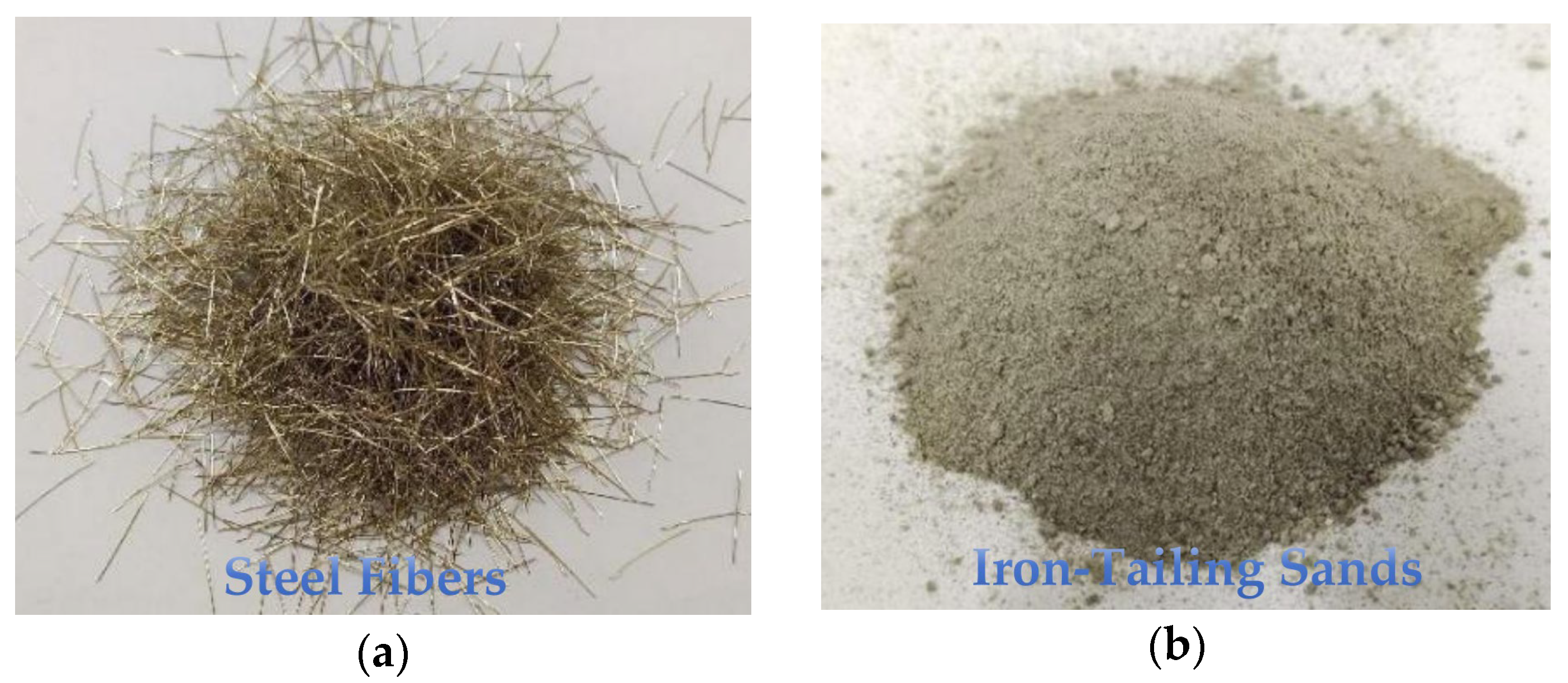
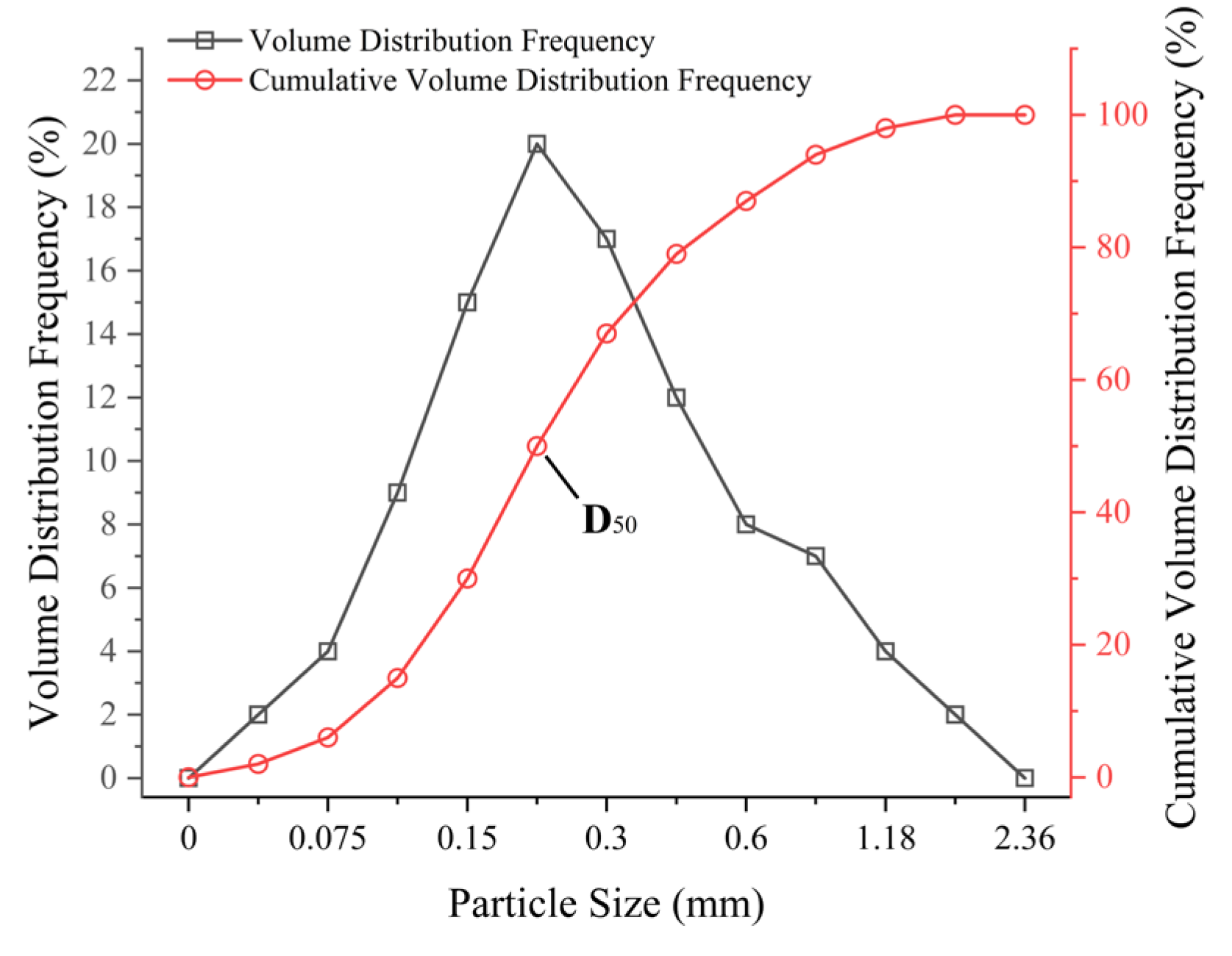

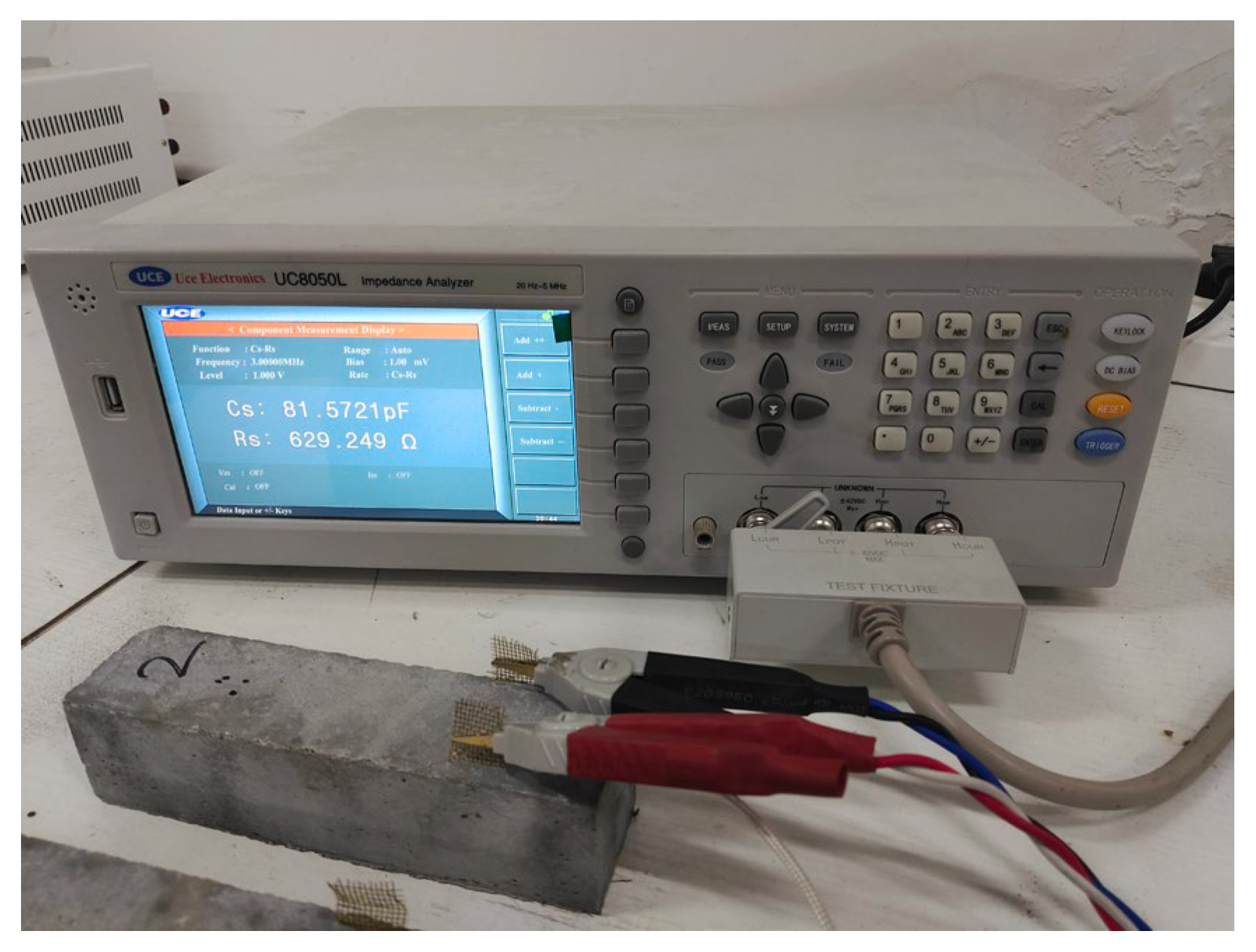

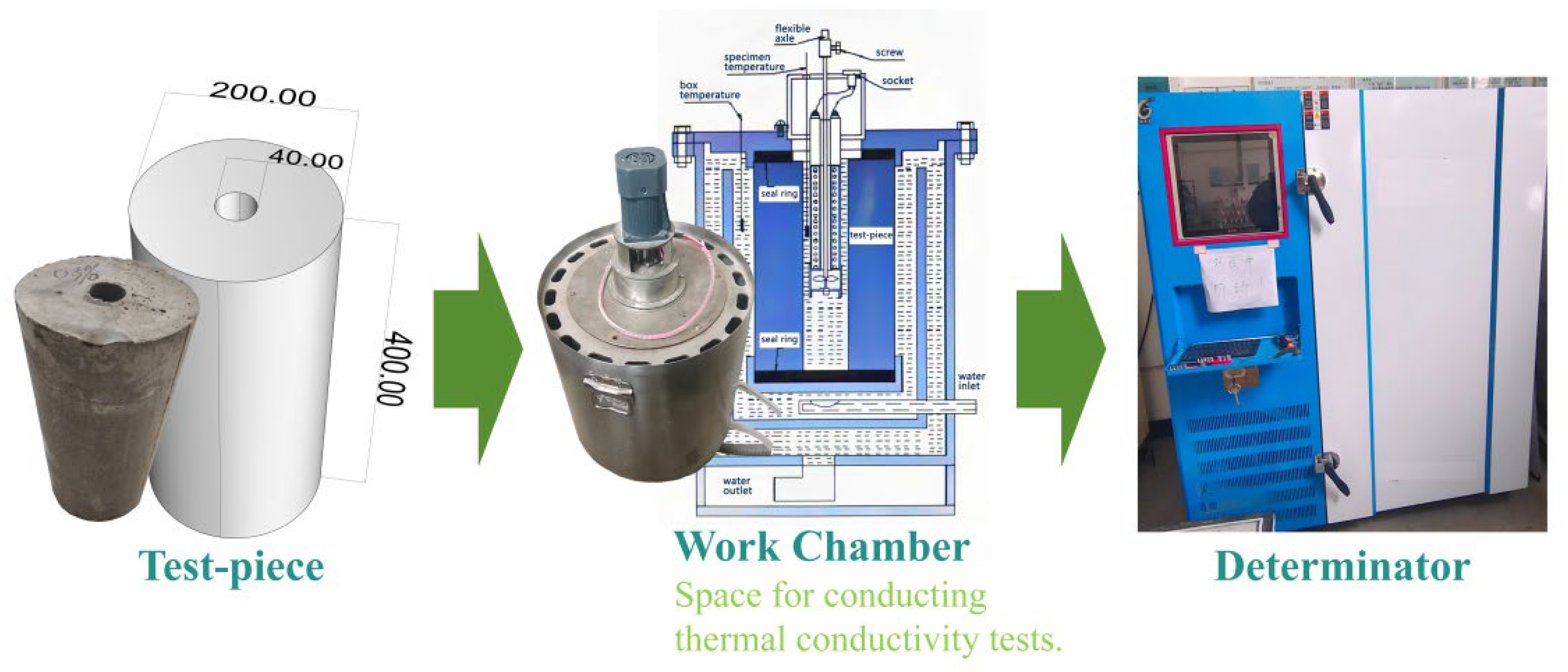
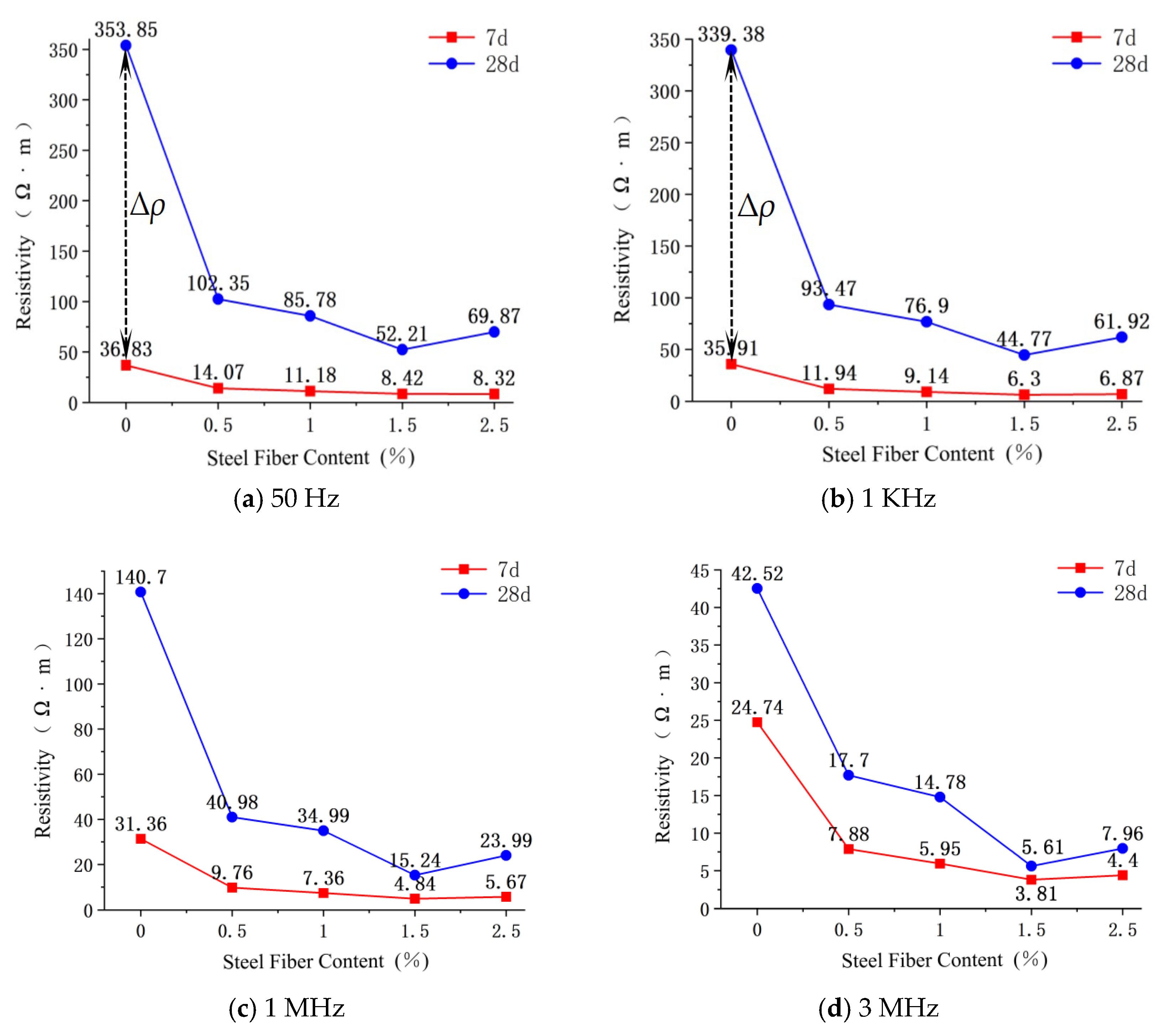

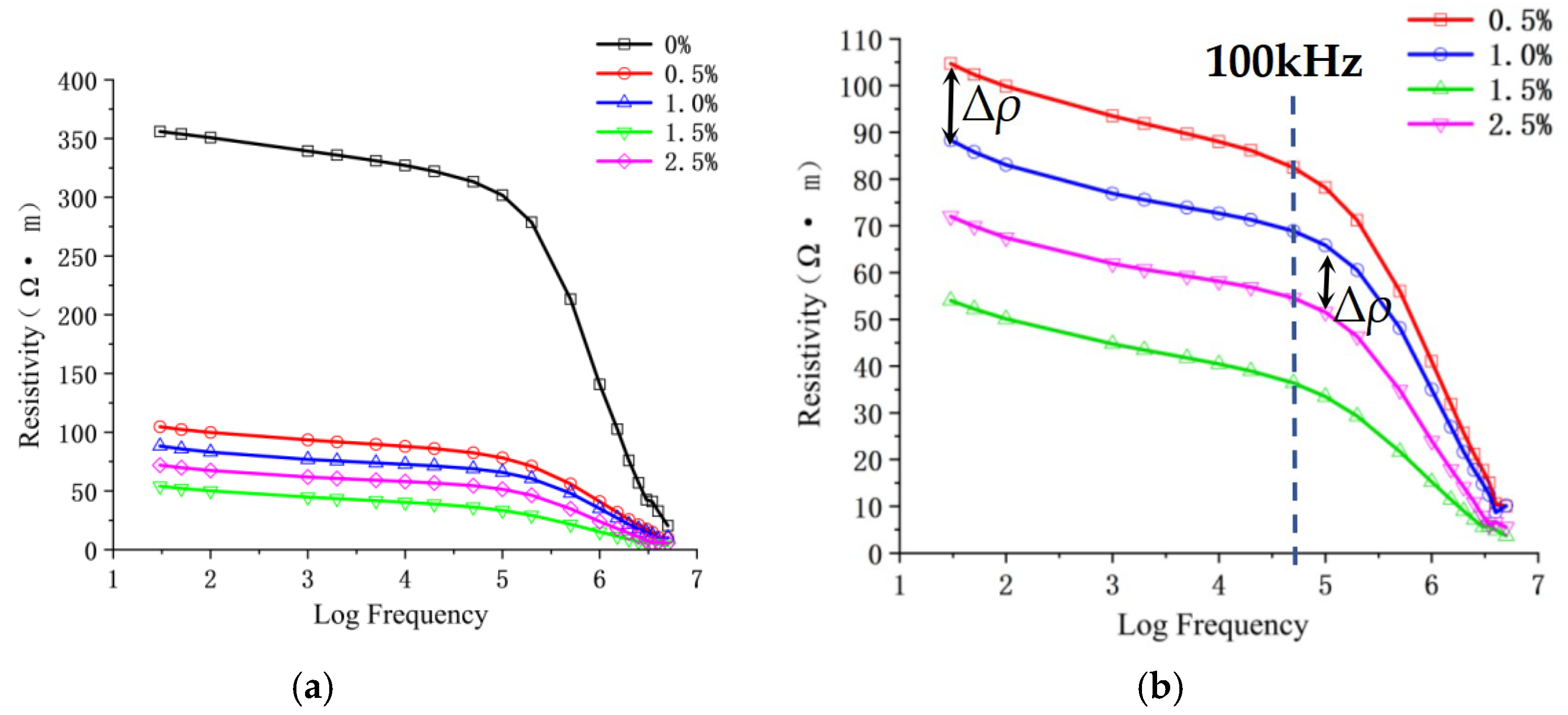


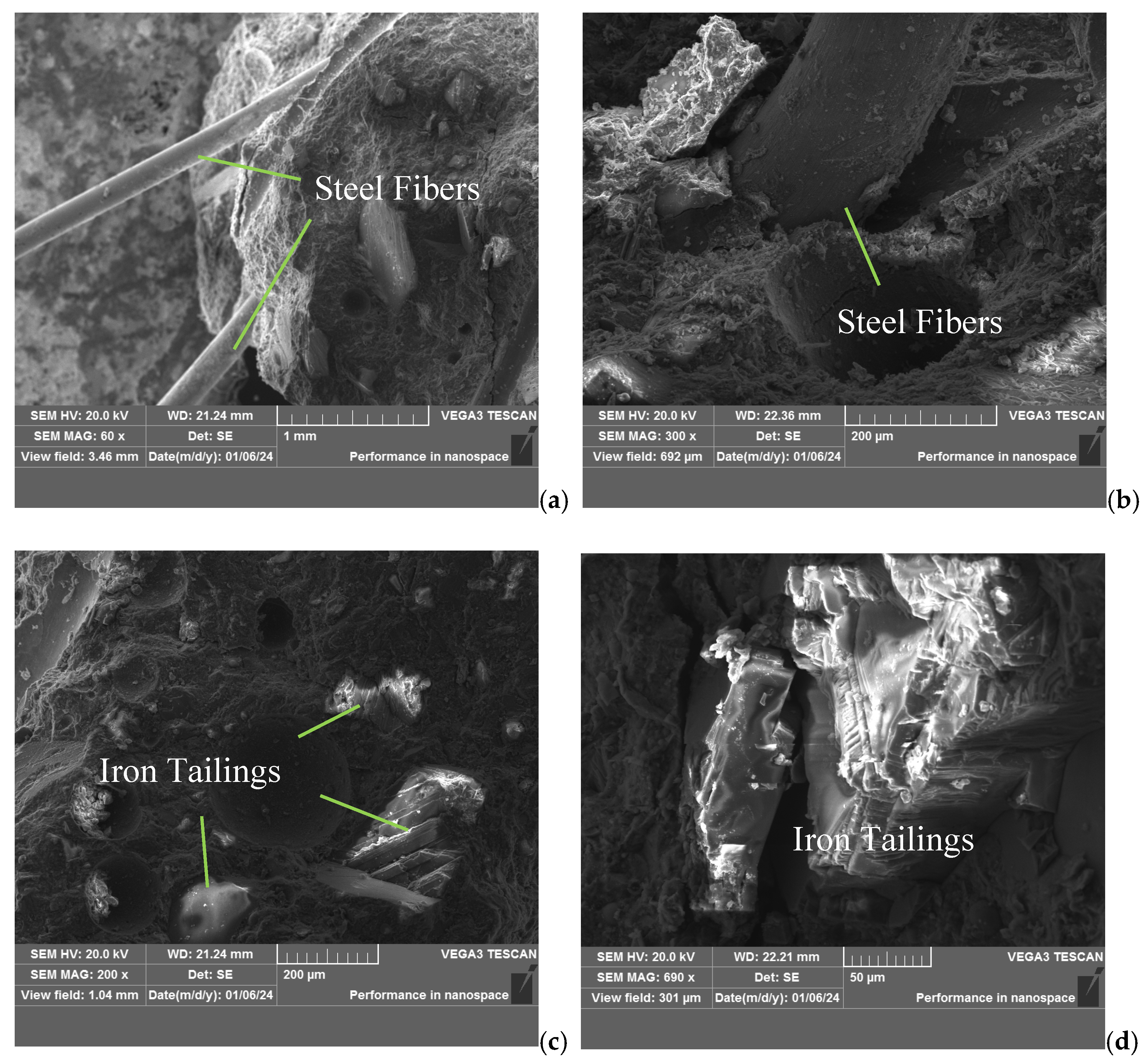
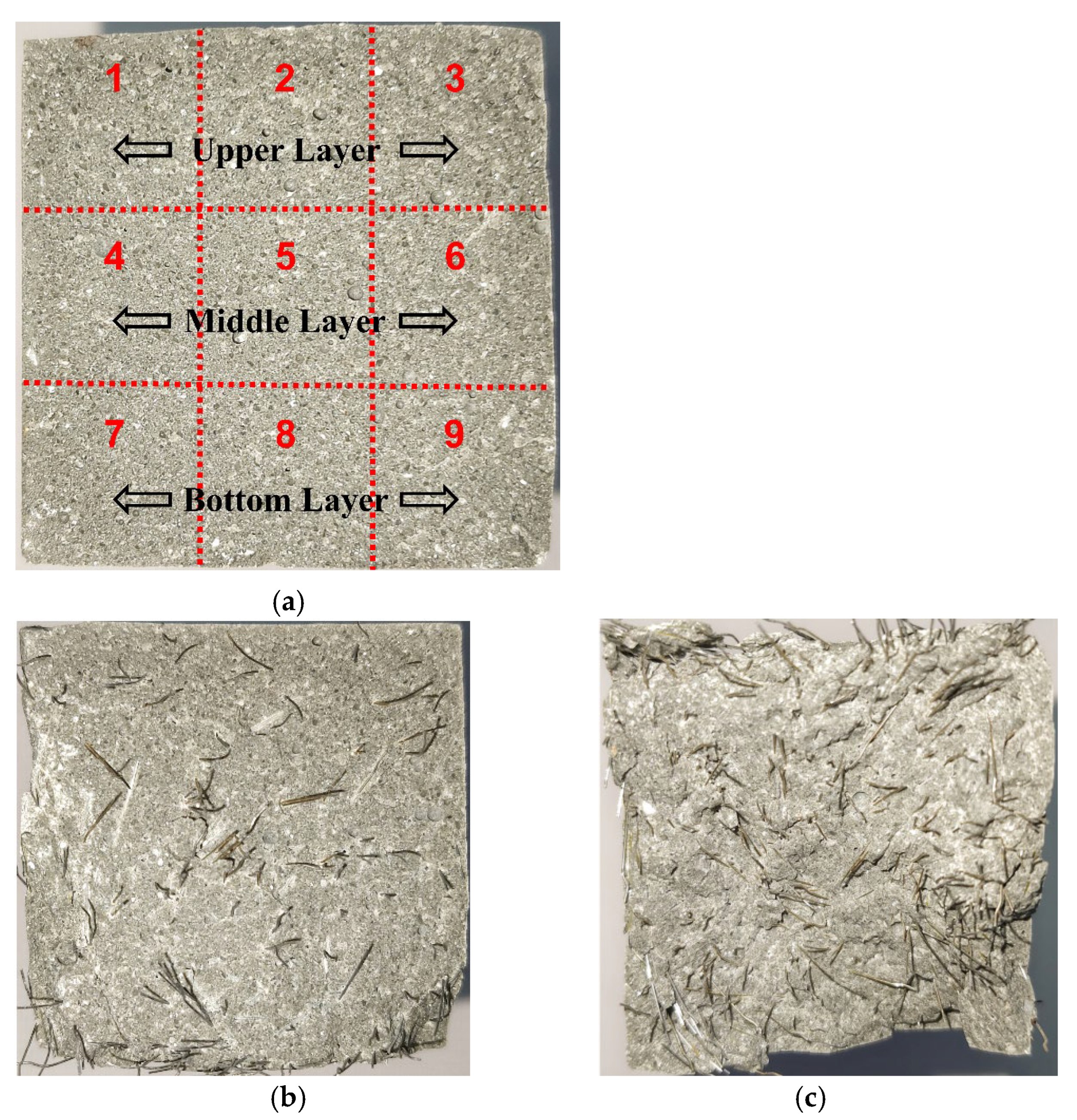

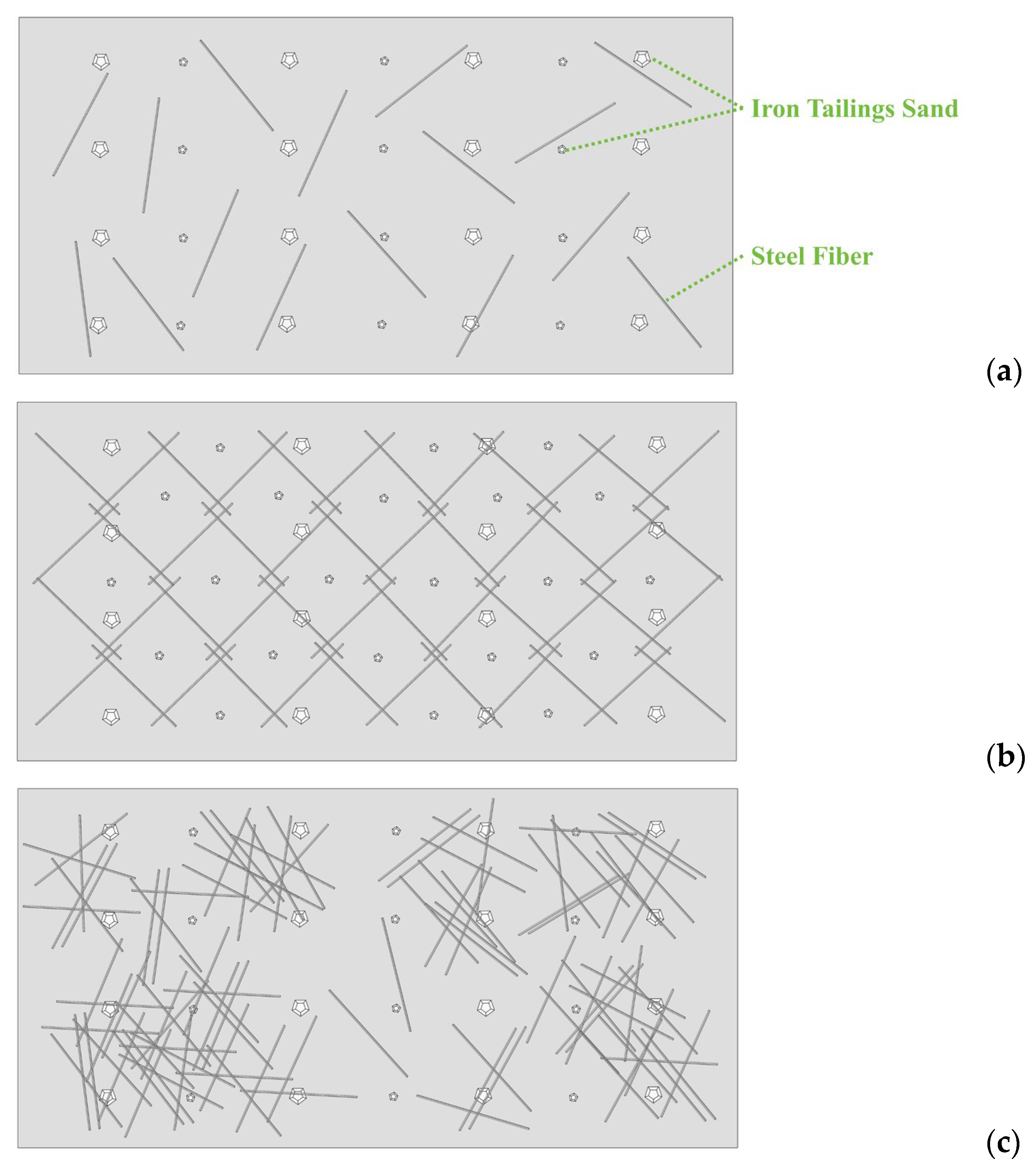
| Constituents | Cement | Silica Fume | Fly Ash | Iron Tailings Sand | Quartz Sand | Water | Superplasticizer |
|---|---|---|---|---|---|---|---|
| Proportion (wt%) | 28.87 | 8.25 | 4.12 | 24.74 | 24.74 | 8.25 | 1.03 |
| Cell Numbering and Layer Position | Number of Steel Fibers in Each Cell of the Cross-Section for Each Material | ||||
|---|---|---|---|---|---|
| SF05 | SF10 | SF15 | SF25 | ||
| 1 | Upper layer | 6 | 13 | 24 | 37 |
| 2 | 5 | 16 | 18 | 57 | |
| 3 | 5 | 11 | 27 | 30 | |
| 4 | Middle layer | 12 | 18 | 23 | 58 |
| 5 | 9 | 23 | 30 | 39 | |
| 6 | 14 | 26 | 31 | 43 | |
| 7 | Bottom layer | 10 | 29 | 37 | 66 |
| 8 | 15 | 23 | 34 | 73 | |
| 9 | 13 | 32 | 41 | 56 | |
| Total number of steel fibers in the cross-section | 89 | 191 | 265 | 459 | |
| Standard deviation of steel fiber count in the cells | 3.66 | 6.79 | 6.85 | 13.60 | |
| Coefficient of variation | 0.37 | 0.32 | 0.23 | 0.27 | |
Disclaimer/Publisher’s Note: The statements, opinions and data contained in all publications are solely those of the individual author(s) and contributor(s) and not of MDPI and/or the editor(s). MDPI and/or the editor(s) disclaim responsibility for any injury to people or property resulting from any ideas, methods, instructions or products referred to in the content. |
© 2025 by the authors. Licensee MDPI, Basel, Switzerland. This article is an open access article distributed under the terms and conditions of the Creative Commons Attribution (CC BY) license (https://creativecommons.org/licenses/by/4.0/).
Share and Cite
Zhen, Q.; Wang, Y.; Zheng, X.; Li, H.; Lin, X.; Wang, J. Effect of Steel Fiber Content on the Electrical, Electrothermal, and Thermal Conductivity Properties of Iron Tailings-Based UHPC. Buildings 2025, 15, 2104. https://doi.org/10.3390/buildings15122104
Zhen Q, Wang Y, Zheng X, Li H, Lin X, Wang J. Effect of Steel Fiber Content on the Electrical, Electrothermal, and Thermal Conductivity Properties of Iron Tailings-Based UHPC. Buildings. 2025; 15(12):2104. https://doi.org/10.3390/buildings15122104
Chicago/Turabian StyleZhen, Qi, Yulin Wang, Xiaoyan Zheng, Henggan Li, Xiaotian Lin, and Jinhua Wang. 2025. "Effect of Steel Fiber Content on the Electrical, Electrothermal, and Thermal Conductivity Properties of Iron Tailings-Based UHPC" Buildings 15, no. 12: 2104. https://doi.org/10.3390/buildings15122104
APA StyleZhen, Q., Wang, Y., Zheng, X., Li, H., Lin, X., & Wang, J. (2025). Effect of Steel Fiber Content on the Electrical, Electrothermal, and Thermal Conductivity Properties of Iron Tailings-Based UHPC. Buildings, 15(12), 2104. https://doi.org/10.3390/buildings15122104






